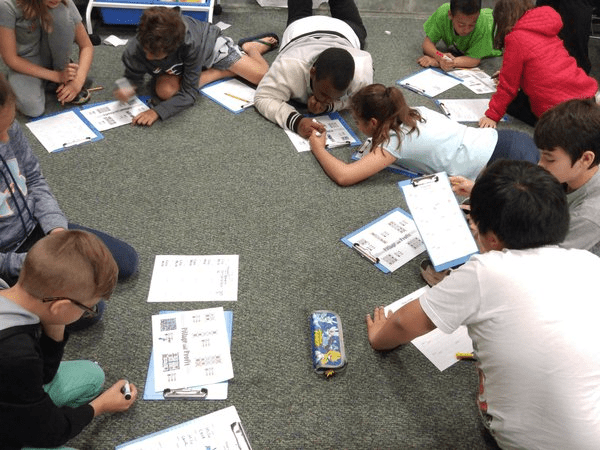Pillage and Profit
(MathPickle, 2015)
Get students involved and practicing algebra from grade 3 forward. Here are the game sheets for the different grades.
PS. The double up and down arrow that you see on the puzzle sheet below means that you can increase or decrease the value of the pictured object.
PPS. I now am experimenting with randomizing which students I call upon rather than systematically going through the whole class. The advantage of this technique is that it keeps students who have just been asked focussed because they could be asked again. If there are some students that you really want to ask, you can increase the odds of drawing their name by secretly adding an additional popsicle stick with their name – or removing the names of others.
One of the things that ultimately led me to leave mathematics and go into political science was thinking I could prevent nuclear war.
Notice that when you use engaging puzzles and games in your classroom management issues drop precipitously. The spontaneous dance you see at 1:03 in the grade 4 classroom video on the right is an example of how one engaged boy chooses to express himself. This is all good 😉
Unlike the grade 3 version, the grade 4 version allows variables to go negative… suddenly all those chicken wings that you stole have gone putrid. Yuk! They are now worth -5 doubloons each!!!
Keeping engagement levels high is aided by having additional game boards that are beautiful and enticing. These should be kept secret until they are used.
They should not be handed out in the same order for all student pairs. Otherwise the fastest students are always the first ones to have the joy of being given a new sheet. Instead, mix it up a bit. Sometimes let a slower group be the first to get a sheet.
Be prepared for students wanting to create their own puzzles and games. This needs to be handled carefully otherwise it can end up in frustration. I tend to err on the side of letting students be creative within constraints. In the example at the end of this video maybe I should have just let the two boys create their own geometric board rather than handing them my own beautifully prepared one. It’s debatable. I’m not sure both students were equally invested the board that one of the boys was drawing, so I think getting them to focus on the algebra and not the board was the correct decision.

Alison Hansel algebraically engages grade 5 students with Pillage & Profit.
Standards for Mathematical Practice
MathPickle puzzle and game designs engage a wide spectrum of student abilities while targeting the following Standards for Mathematical Practice:
MP1 Toughen up!
Students develop grit and resiliency in the face of nasty, thorny problems. It is the most sought after skill for our students.
MP2 Think abstractly!
Students take problems and reformat them mathematically. This is helpful because mathematics lets them use powerful operations like addition.
MP3 Work together!
Students discuss their strategies to collaboratively solve a problem and identify missteps in a failed solution. Try pairing up elementary students and getting older students to work in threes.
MP4 Model reality!
Students create a model that mimics the real world. Discoveries made by manipulating the model often hint at something in the real world.
MP5 Use the right tools!
Students should use the right tools: 0-99 wall charts, graph paper, mathigon.org. etc.
MP6 Be precise!
Students learn to communicate using precise terminology. Students should not only use the precise terms of others but invent and rigorously define their own terms.
MP7 Be observant!
Students learn to identify patterns. This is one of the things that the human brain does very well. We sometimes even identify patterns that don't really exist! 😉
MP8 Be lazy!?!
Students learn to seek for shortcuts. Why would you want to add the numbers one through a hundred if you can find an easier way to do it?
Please use MathPickle in your classrooms. If you have improvements to make, please contact me. I'll give you credit and kudos 😉 For a free poster of MathPickle's ideas on elementary math education go here.